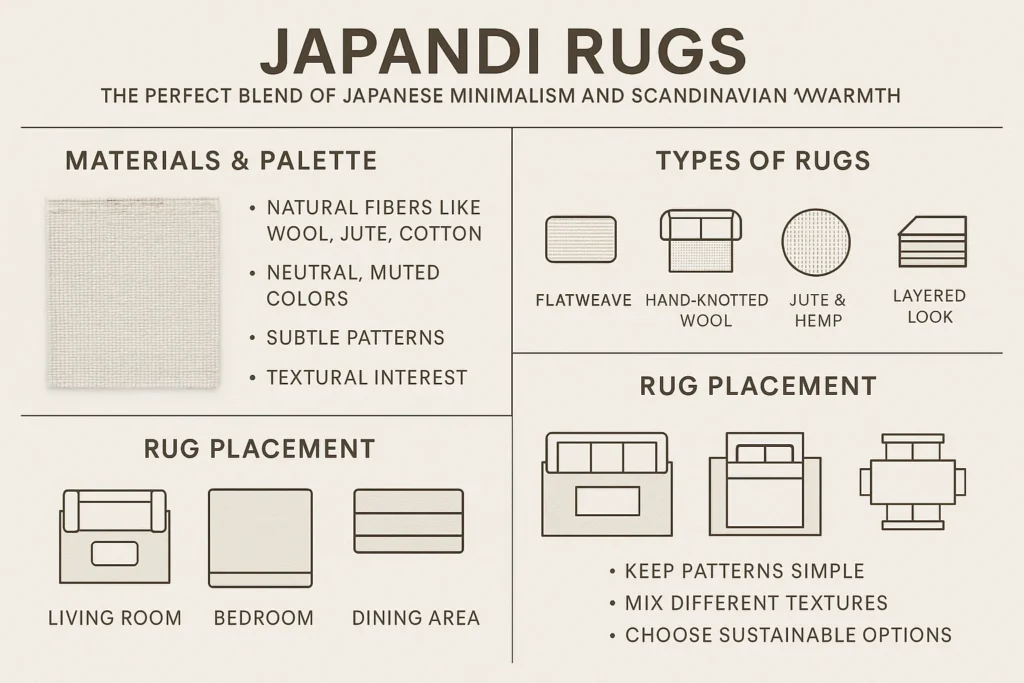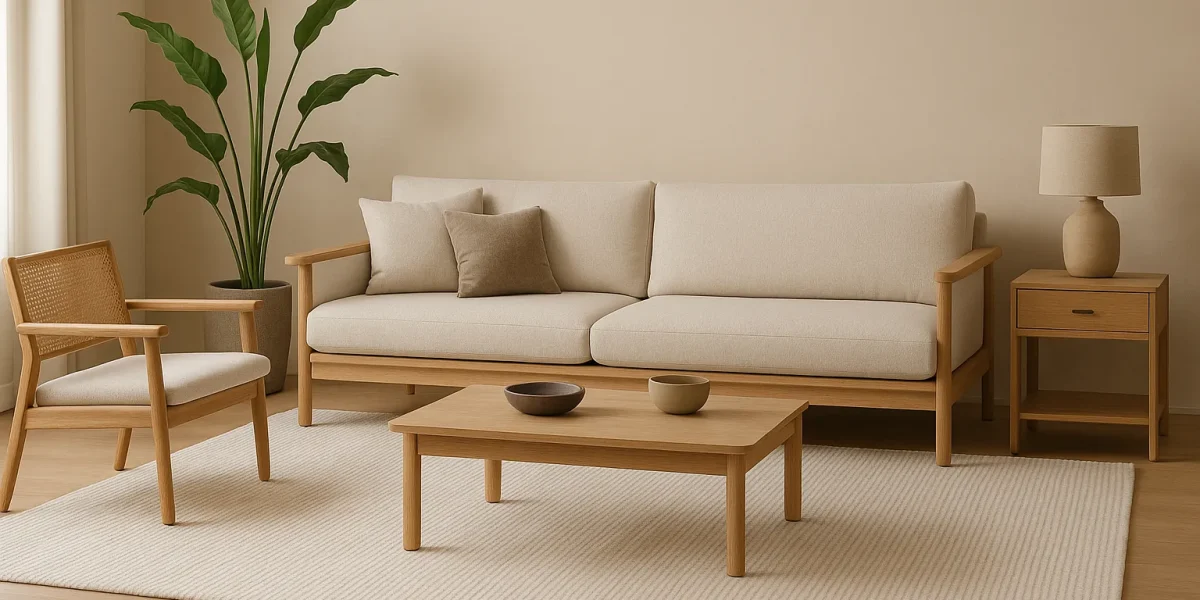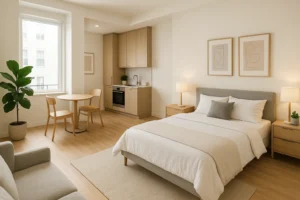Imagine stepping into a living room where every element feels intentional. The sunlight filters through soft linen curtains, a low-profile oak table anchors the space, and beneath your feet, a Japandi rug offers both visual serenity and physical comfort. This isn’t just a floor covering — it’s the grounding piece that ties an entire aesthetic together.
Japandi style, a harmonious blend of Japanese minimalism and Scandinavian coziness, has taken the interior design world by storm. At its core, it’s about simplicity, natural beauty, and functional elegance. And while furniture and lighting often steal the spotlight, Japandi rugs quietly hold the power to transform a room from “nice” to “breathtaking.”
The Essence of Japandi Design Philosophy
Japandi isn’t just a design trend — it’s a lifestyle choice rooted in two distinct yet compatible philosophies.
- From Japan comes wabi-sabi, the appreciation for imperfection and natural beauty.
- From Scandinavia comes hygge, the pursuit of comfort and warmth in everyday living.
When combined, these principles create spaces that are calm yet inviting, structured yet relaxed. The rug, in a Japandi setting, plays a crucial role in delivering that warmth without overwhelming the clean lines and neutral palette the style is known for.
What Makes a Rug ‘Japandi’?
Natural Materials that Breathe
Japandi rugs are almost always crafted from organic or sustainably sourced materials. Wool, jute, cotton, hemp — these fibers bring not just tactile beauty but also an eco-conscious ethos. A wool-viscose blend, for example, offers the luxurious softness of wool with the subtle sheen and structural integrity of viscose.
Neutral & Muted Palettes
Earthy tones dominate — think warm beiges, soft greys, gentle taupes, muted greens, and occasionally charcoal for contrast. These shades harmonize effortlessly with Japandi’s signature light woods and minimal decor.
Minimal Patterns & Subtle Textures
Instead of bold prints, Japandi rugs lean into texture. A handwoven wool rug with a slight ribbed finish can add depth without disrupting visual calm. Linear patterns or tone-on-tone geometrics keep the style understated.
Low Profile & Timeless Shapes
Flatweaves, hand-knotted designs, and low-pile rugs fit perfectly under furniture without creating bulky transitions. Rectangular and runner styles dominate, with occasional round rugs for balance in compact spaces.
Types of Japandi Rugs & Where They Work Best
- Flatweave Rugs – Ideal for dining rooms and entryways; easy to clean and lightweight.
- Hand-Knotted Wool Rugs – Soft and luxurious; perfect for bedrooms or reading corners.
- Jute & Hemp Rugs – Rustic texture; excellent for layering or casual living spaces.
- Layered Rugs – A flatweave base with a smaller wool rug on top adds depth and warmth.
Choosing the Perfect Japandi Rug for Your Home
a) Match Rug Size to Room Layout
A rug that’s too small can make a room feel disconnected; too large, and it swallows the space. Use these guidelines:
- Living Room: Large enough to fit front legs of all seating.
- Bedroom: Extend 18–24 inches beyond each side of the bed.
- Dining Room: Allow 24 inches of rug beyond the table to accommodate pulled-out chairs.
b) Consider Light & Flooring
Light-toned rugs open up smaller rooms, while darker tones can ground airy spaces. Pair beige rugs with light oak floors for continuity or contrast dark charcoal rugs against whitewashed floors for drama.
c) Keep Function in Mind
Families with kids or pets might prefer stain-resistant wool blends or indoor-outdoor rugs that mimic natural fibers. For low-traffic reading nooks, a plush hand-knotted rug adds indulgence.
Styling Japandi Rugs in Different Rooms
Living Room – Use the rug to define the seating area, pairing it with low-profile sofas and simple coffee tables. Layer in linen cushions and wooden accents.
Bedroom – Place the rug under the bed so it extends on both sides, giving your feet a warm landing each morning. Pair with neutral bedding and a single branch in a ceramic vase.
Dining Area – Choose a flatweave or low-pile rug for easy cleaning. Keep patterns subtle so the tableware remains the focal point.
Home Office – A neutral-toned rug can soften the echo of hard floors, making the workspace feel calmer and more focused.
Japandi Rugs on a Budget vs. Luxury Options
- Budget-Friendly – Cotton blends, machine-woven neutrals under $200.
- Mid-Range – Handwoven wool or jute rugs, $300–$800.
- Luxury – Artisan-made, hand-knotted designs in pure wool or silk blends, often $1,000+.
Tip: If you’re working with affiliate content, you can easily link to budget and luxury options, guiding readers through various price tiers.
Care & Maintenance for Japandi Rugs
- Vacuum weekly using a low-suction setting to preserve fibers.
- Rotate the rug every 6 months to avoid uneven fading.
- Blot spills immediately — rubbing can damage fibers and set stains.
- For deep cleaning, opt for eco-friendly solutions like diluted vinegar or baking soda for odor removal.
Sustainability & Ethical Sourcing
Japandi aligns naturally with eco-conscious living. When shopping:
- Look for Fair Trade certifications.
- Choose rugs made from organic materials.
- Support small-scale artisans who produce rugs in limited batches.
Expert Tips & Styling Secrets
- “A Japandi rug should whisper, not shout,” says interior stylist Lina Sorensen. Keep the palette soft and the texture rich.
- Mix textures — a jute rug under a soft wool runner creates layers without visual clutter.
- Stick to one color family to maintain Japandi harmony.
Conclusion – Your Rug as the Heart of Japandi Living
A Japandi rug is more than just a decorative piece. It’s a grounding force, a texture-rich foundation that quietly supports every other design choice in your home. By choosing one thoughtfully — considering size, material, color, and sustainability — you’re investing in comfort, calm, and timeless style.
Whether you prefer a budget-friendly flatweave or a hand-knotted heirloom, the right Japandi rug will do exactly what this design philosophy promises: blend beauty and function in perfect harmony.



